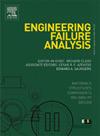Fragility analysis of RC columns confined with CFRP grid-reinforced ECC under vehicle collisions
IF 4.4
2区 工程技术
Q1 ENGINEERING, MECHANICAL
引用次数: 0
Abstract
Bridge piers and building columns are susceptible to impact loading, particularly from vehicle collisions, posing a significant threat to public safety. Carbon fiber reinforced polymer (CFRP) grid-reinforced engineering cementitious composite (ECC) is a promising material for enhancing the resistance of regular reinforced concrete (RC) columns. This study numerically investigates the dynamic performance of RC columns confined with CFRP grid-reinforced ECC under vehicle collision and compares them with standard RC columns. The numerical results indicate that the strengthening method can significantly reduce displacement during the collision process, while the impact forces on the two types of columns are very similar. Additionally, the ECC material demonstrates strong energy dissipation capacity. To evaluate the anti-collision performance of the columns, the impact fragility of both types of columns is assessed using a surrogate model called Gaussian process regression, considering multiple variables. The augment uniform design sampling method is utilized to generate homogeneous samples, and fragility is derived based on Monte Carlo simulations. The fragility results show that for the same impact intensity, the failure probability of retrofitted columns is greatly reduced compared to regular RC columns. Finally, a global Sobol sensitivity analysis is conducted to identify the sensitive variables during collision.
碳纤维布网架加筋ECC约束RC柱在车辆碰撞下的脆性分析
桥墩和建筑物的柱子容易受到冲击载荷的影响,尤其是来自车辆碰撞的冲击载荷,对公众安全构成重大威胁。碳纤维增强聚合物(CFRP)网格增强工程胶凝复合材料(ECC)是一种很有前途的增强普通钢筋混凝土(RC)柱抗力的材料。本文通过数值模拟研究了碳纤维布网架加筋ECC约束的混凝土柱在车辆碰撞下的动力性能,并与标准混凝土柱进行了比较。数值计算结果表明,该加固方法能显著减小碰撞过程中的位移,且两种柱受到的冲击力非常接近。此外,ECC材料具有较强的耗能能力。为了评估列的抗碰撞性能,考虑多个变量,使用称为高斯过程回归的代理模型评估两种类型列的冲击脆弱性。采用增强均匀设计抽样法生成均匀样本,并基于蒙特卡罗模拟导出脆性。脆性分析结果表明,在相同的冲击强度下,加固柱的破坏概率比普通钢筋混凝土柱大大降低。最后,进行全局Sobol灵敏度分析,识别碰撞过程中的敏感变量。
本文章由计算机程序翻译,如有差异,请以英文原文为准。
求助全文
约1分钟内获得全文
求助全文
来源期刊

Engineering Failure Analysis
工程技术-材料科学:表征与测试
CiteScore
7.70
自引率
20.00%
发文量
956
审稿时长
47 days
期刊介绍:
Engineering Failure Analysis publishes research papers describing the analysis of engineering failures and related studies.
Papers relating to the structure, properties and behaviour of engineering materials are encouraged, particularly those which also involve the detailed application of materials parameters to problems in engineering structures, components and design. In addition to the area of materials engineering, the interacting fields of mechanical, manufacturing, aeronautical, civil, chemical, corrosion and design engineering are considered relevant. Activity should be directed at analysing engineering failures and carrying out research to help reduce the incidences of failures and to extend the operating horizons of engineering materials.
Emphasis is placed on the mechanical properties of materials and their behaviour when influenced by structure, process and environment. Metallic, polymeric, ceramic and natural materials are all included and the application of these materials to real engineering situations should be emphasised. The use of a case-study based approach is also encouraged.
Engineering Failure Analysis provides essential reference material and critical feedback into the design process thereby contributing to the prevention of engineering failures in the future. All submissions will be subject to peer review from leading experts in the field.
 求助内容:
求助内容: 应助结果提醒方式:
应助结果提醒方式:


